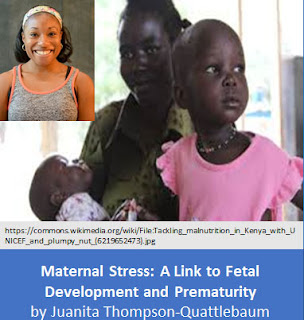Maternal Stress: A Link to Fetal Development and Prematurity
by Juanita Thompson-Quattlebaum
MBS 2018, Geisinger Commonwealth School of Medicine
Mentor: Pamela Lucchesi, PhD
The human gestational period (length of pregnancy) is 40 weeks. This period is broken into smaller three-month periods called trimesters. Prematurity occurs when a baby is born before 37 weeks gestation. Delivering preterm has many potential complications for the baby because the infants have not had enough time to develop. Because the babies haven’t had enough time to develop, they may have issues with their lungs, intestines, eyes and brain.
Complications can be very costly. Healthcare providers must be sure that the preemie is strong enough to leave the hospital. In addition, these children could have complications that will remain with them for the rest of their lives. Possible, long-term difficulties include respiratory illness, blindness and cerebral palsy or an increased chance of developing issues like diabetes later in life. Although prematurity can lead to serious problems, not every preemie will experience the most common life-long issues.
One of the major questions scientists have is, “What causes a baby to be premature?” Research has shown that maternal stress during pregnancy is a major contributor to preterm delivery. Despite efforts to minimize the negative outcomes and learn more about the causes, 12% of all births in the United States are premature and prematurity is the leading cause of infant death. With continuously rising rates of preterm birth, this is a major public health concern.
My older sister was born prematurely and had to spend months in the hospital getting stronger. Luckily, she has not had any severe long-term complications. As the younger sister, I have always wondered why my mother had a longer pregnancy with me, than she did with my sister. Could it have been because of the difference of stress in my mother’s life? I wanted to understand the role maternal stress plays on fetal development and prematurity.
Research data suggest that prematurity may be multifactorial. This means that the combination of a few things can lead to preterm delivery. Among the most investigated factors shown to have an association with increased risk of prematurity were maternal stress (physical, emotional or mental), fetal imprinting or changes in the unborn babies' genes and family inheritance of risk, also called heritability. In the U.S, as many as 12.7% of pregnant women experience at least one major depressive episode, meaning a complete feeling of helplessness or distress. This means than a person feels this way for more than two weeks. While measuring the effects of maternal stress, it was observed that there is a 1.5-increased risk of delivering prematurely when the mother experiences stress during pregnancy. Additionally, the mother's stress response or the way the body responds to stress can play a role in the outcomes.
Stress alters the release and response to hormones like serotonin, dopamine and corticotrophin-releasing hormone (CRH). These hormones mediate the stress response but also play a role in fetal development. Changing the concentration or reaction to these hormones can modify the methylation of fetal genes. This means that the baby’s DNA is altered, a phenomenon called "imprinting". This could result in long-term gene expression changes. Because the DNA is modified, researchers have studied the heritability of prematurity. Observations on history of preterm delivery (PTD) of mothers has revealed that full and half-sisters were 55% (95% CI: 49, 61) more likely to deliver prematurely than women without such history, thus positively identifying a maternal lineage of premature risk.
With all of the research and evidence on maternal stress and the potential effects on prematurity, the trend continues to increase. However, it is clear that many women experience stress during pregnancy and don’t deliver prematurely. In the same respect, like my older sister, not every preemie suffers long-term complications. The concept of combined causes appears to be plausible. Each factor increases the risk of prematurity and adverse outcomes. Maybe this is why I was delivered almost full term.
Further studies to develop screening techniques that detect premature delivery risks, and better maternal management of stress and care are necessary to reduce the financial impact of prematurity and hopefully minimize its prevalence.
Watch the animation:https://www.powtoon.com/online-presentation/fi9p4g66dKJ/?mode=movie#/



Comments
Post a Comment